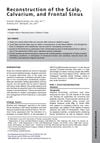TLDR Tailored scar treatments are needed for different body areas to improve appearance and function.
The document discussed the challenges of managing scars in specific anatomical areas, highlighting the impact of scarring on the scalp, face, chest, hands, feet, and large joints. Scalp scarring could lead to alopecia, which was particularly stigmatizing for women and children. Facial and chest scars affected aesthetics and quality of life, while scarring on hands, feet, or joints could impair function. Effective scar management required tailored approaches, such as local flaps for contracted scars, dermal substitutes, skin grafting, and fractional lasers for texture improvement. Combining treatments based on individual scar needs, along with physiotherapy and conservative methods, was recommended to prevent future scarring and maintain function.
 8 citations
,
January 2015 in “Scars, burns & healing”
8 citations
,
January 2015 in “Scars, burns & healing” Hair transplantation effectively treats burn scar alopecia, improving self-esteem and confidence.
 6 citations
,
July 2017 in “Clinics in Plastic Surgery”
6 citations
,
July 2017 in “Clinics in Plastic Surgery” The document concludes that individualized reconstruction plans are essential for improving function and appearance after head and neck burns.

The conclusion is that closing scalp wounds is possible, but restoring hair without donor material is still a major challenge.
 55 citations
,
October 2009 in “Clinics in Plastic Surgery”
55 citations
,
October 2009 in “Clinics in Plastic Surgery” Burn reconstruction improves with new techniques, materials, and tissue engineering.
 17 citations
,
May 2013 in “Oral and Maxillofacial Surgery Clinics of North America”
17 citations
,
May 2013 in “Oral and Maxillofacial Surgery Clinics of North America” The document concludes that careful surgical methods and choosing the right materials are key for successful scalp, skull, and frontal sinus reconstruction.
 November 2008 in “Medical & surgical dermatology”
November 2008 in “Medical & surgical dermatology” A device was made in 2008 to measure hair loss severity. Other findings include: frizzy mutation in mice isn't related to Fgfr2, C/EBPx marks preadipocytes, Cyclosporin A speeds up hair growth in mice, blocking plasmin and metalloproteinases hinders healing, hyperbaric oxygen helps ischemic wound healing, amniotic membranes heal wounds better than polyurethane foam, rhVEGF165 from a fibrin matrix improves tissue flap viability and induces VEGF-R2 expression, and bFGF enhances wound healing and reduces scarring in rabbits.






